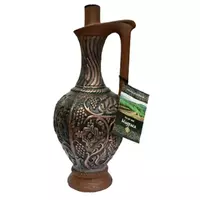Madrasa wine

Archaeologists have found evidence that winemaking was developed on the territory of modern Azerbaijan back in the 5th millennium BC. In the Akstafa region in the vicinity of the town of Shomutele in the territory of the modern independent Republic of Azerbaijan back in 1962, as a result of large-scale archaeological excavations of ancient human settlements, grape seeds were discovered.
By determining the age of the seeds, scientists were able to establish that winemaking developed in the region from about the end of the 3rd millennium BC. The rich wine-growing tradition of the region began to fade when the Muslim religion was entrenched in the state, which does not encourage the use of alcoholic beverages, including wine. Over time, table drinks made from kishmish, as well as the so-called raisin grapes, became popular in the region.
Researchers believe that all grape varieties growing in the territory of modern Azerbaijan came from wild grapes. The person was directly involved in this process. To obtain new grape varieties, people constantly crossed vine varieties growing in the region.
As a result of constant selection, as well as natural selection, the fund of local grapes in Azerbaijan was replenished with a huge number of various plant species. It is worth noting that vineyards of various economic importance grow in Azerbaijan. Currently, Azerbaijani winemakers use over 450 types of grapes for wine production.
Among the most famous and popular grapes far beyond the borders of Azerbaijan can be distinguished Kishmish, Tabrizi, Merendi, as well as Madras. Madrasa wine is one of the vintage wines that make up the so-called "golden fund" of the ancient Azerbaijani wine-making tradition. The noble drink is distinguished by its unique blend of taste and aroma.
Madrasa wine refers to table dry red wines, which are distinguished by a high percentage of sugar in their chemical composition (not higher than 28%). In addition, the fortress of Madrasa wine is no more than 12%. It is worth noting that the grape variety from which Madras wine is made is distinguished by its vitamin and mineral composition.
Due to the characteristic features of the grapes, Madras acquires a deep rich taste, which is so characteristic of Caucasian wines. Professional tasters and sommeliers claim that the taste of real Azerbaijani wine Madrasa is significantly superior to similar varieties of Moldavian and Georgian wines. Like most Azerbaijani table wines, Madras is perfectly combined with meat dishes, azoo, kebabs and pilaf.
madras wines (madrasa) 64 kCal
Energy value of madras wine (madrasa) (Ratio of proteins, fats, carbohydrates - ju):
Proteins: 0.2 g (~ 1 kCal)
Fats: 0 g (~ 0 kCal)
Carbohydrates: 0.3 g (~ 1 kCal)
Energy ratio (bj | y): 1% | 0% | 2%
 Español
Español Français
Français Português
Português Русский
Русский 简体中文
简体中文 繁體中文
繁體中文 日本語
日本語 한국어
한국어 العربية
العربية Türkçe
Türkçe Қазақ
Қазақ Deutsch
Deutsch Italiano
Italiano Українська
Українська
